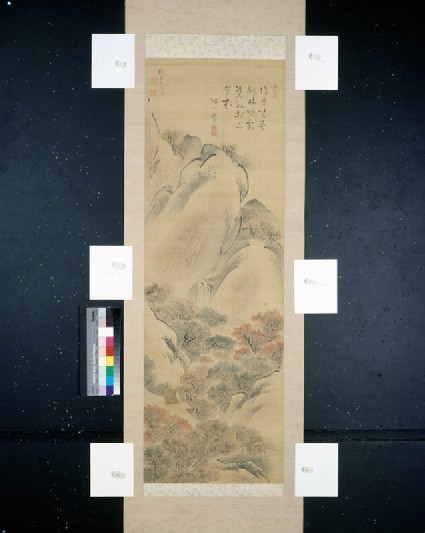Browse: 772 objects
- Reference URL
Actions
Viewing a waterfall
-
Details
- Associated place
-
Asia › Japan › Honshū › Kyōto prefecture › Kyoto (possible place of creation)
- Date
- 1800 - 1825
- Artist/maker
-
Ki no Chikudō (died 1825) (artist)Du Mu (AD 803 - 852) (author)Tōjo Itsudō (1778 - 1857) (calligrapher)
- Material and technique
- ink and colour on silk
- Dimensions
- 97.79 x 32.38 cm (height x width)
- Material index
-
organic › animal › animal product › silk,
- Technique index
- Object type index
- No. of items
- 1
- Credit line
- Purchased with the assistance the Higher Studies Fund, the Victoria and Albert Museum Fund, and with donations from the friends of P. C. Swann, 1966.
- Accession no.
- EA1966.123
-
Further reading
Katz, Janice, Japanese Paintings in the Ashmolean Museum, Oxford, with an introductory essay by Oliver Impey (Oxford: Ashmolean Museum, 2003), no. 2 on pp. 44-45, p. 39, illus. p. 45
Location
-
- currently in research collection
Objects are sometimes moved to a different location. Our object location data is usually updated on a monthly basis. Contact the Jameel Study Centre if you are planning to visit the museum to see a particular object on display, or would like to arrange an appointment to see an object in our reserve collections.
Publications online
-

Japanese Paintings in the Ashmolean Museum
Works by this artist are rare, and among them, his paintings are virtually unknown. Kinei Chikudō (not to be confused with Kishi Chikudō) is best known for his album of prints in the British Museum entitled Chikudō gafu, published in Kyoto in 1800 and 1815, one of the greatest achieve¬ments of the illustrated printed book form in Japan. The image in the Ashmolean’s collection is of a subject that was Chikudō's speciality, figures in a landscape done in the literati style. He was from Kyoto, and is listed in contemporary artist compendiums such as the Gajōyōryakū (1831) as a pupil of Murakami Tōshū (fl. c. 1800).
In the painting, a scholar sits on a rocky plateau leaning on his arm extended behind him as he gazes up at a waterfall in the crevice between two towering mountains. Below him, two figures seen only from the shoulders up stand behind a cart. The season is early autumn as the trees display their full foliage, some of which is beginning to turn red. The artist has clearly taken his inspiration for the image from the famous Tang Chinese verse entitled ‘A Mountain Excursion’, by Du Mu (803-852), which is inscribed in part above by Tō jō Itsudō (1778-1857), a scholar from Kazusa:
I stop the carriage and sit [awhile]
to enjoy the maple wood at dusk,
The frost-touched leaves are more brightly red
than the second month’s flowers.
Viewing a Waterfall and the Chikudō gafu are consistent in style, though one is a painting and the other prints. Mountain forms are rendered with broken, gently curving outlines. The ink washes which delineate the rocky crevices are in turn covered with few texture strokes. The figures have wide noses and dots for eyes, always with a quietly contented expression. Scholars, sages and labourers are all treated in the same manner. Chikudō's style of Nanga is soft and soothing with no angles or jarring colours: this evokes a sense of calm and tranquillity.
© 2013 University of Oxford - Ashmolean Museum

